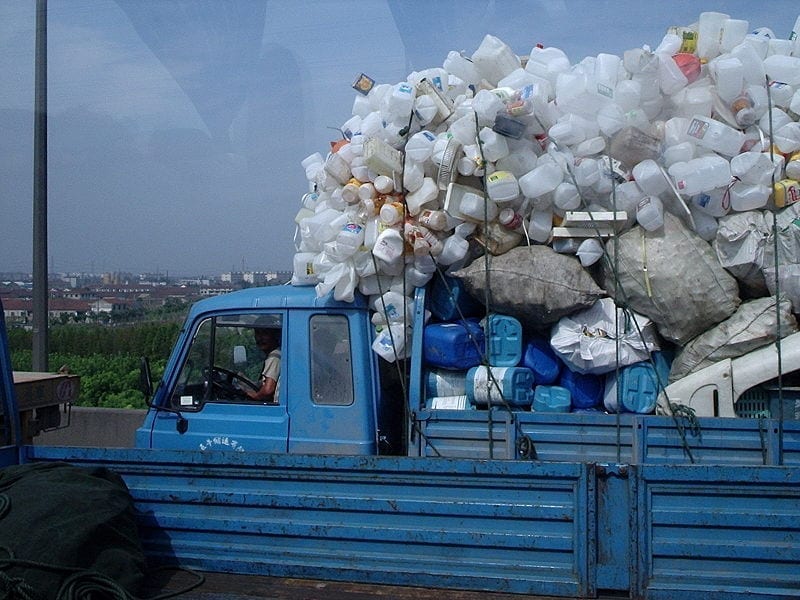In the old days, the rag and bone man collected discards and closed the waste loop. Globalization helped kill him, but will isolationism bring him back?
Recycling used to be an intensely local affair. In Europe during the 19th and early 20th centuries, the rag and bone man (also called a “bone-grubber” or “totter”) would wind through neighborhoods with a horse and cart (or cargo van), calling for all to bring out their scraps and waste for him to cart away. Old clothes, which usually passed through many hands before finally being discarded as rags, were destined to be remade into new cloth or paper. Bones were the raw material for industries from glue-making to fertilizer, or could be carved into knobs and ornaments. The rag and bone man collected other items too, such as scrap metal for sale or for the war effort. He was eventually rendered obsolete a generation ago due to the low value of used materials, municipal trash pickup, and regulation.
Nowadays, we’re used to dropping our recyclables in curbside bins or taking them to a collection site ourselves, whether we drop them at a recycling center or a dump. Scarcity once demanded that we make the most of every resource, but the tsunami of industrially manufactured, inexpensive goods now available means that we haven’t had to be as frugal. The post-consumer afterlife of our discards went global, much as our jobs and manufacturing did, and instead of completing the waste cycle in our own back yards, now plastic water bottles and printer paper may cross the globe before being reborn into something new.
Or at least they did until recently.
An ascendant China seems increasingly dissatisfied at the prospect of taking on the world’s pollution burden. Western countries have long been able to clean up their air and water by outsourcing their manufacturing waste to China along with their factory jobs, but last month, China deployed over 60,000 soldiers to plant trees to combat the smog in their heavily polluted provinces. Likewise, China stopped accepting most of our waste in 2018, claiming that much of what the world sent was dirty, hazardous, improperly sorted, or not recyclable to begin with. Honestly, who would want it?

China’s refusal to act as the global rag and bone man is disrupting the world’s flow of recyclables. In Britain, plastic recyclables have been piling up; London had to pay money to have them carted away. Similar gluts have been reported in Canada, Germany, Ireland, Hong Kong, and in cities throughout the United States. Calgary, alone, now has five million kilograms (over 11 million pounds) of recyclables piled up with nowhere to go.
As we all know, poop rolls downhill. In the short term, waste companies are looking for alternative dump sites for the collected detritus of our industrial culture, which likely means poorer and darker neighborhoods and countries. (Even Trump’s EPA admits environmental racism is real.) Recyclers in Oregon are hoping to unload their stockpile as far away as Indonesia, Vietnam, Malaysia, or India. Taking our trash is a mixed blessing for impoverished countries, because while it results in a growing environmental disaster, our discards are often seen as a valuable source of raw materials and jobs for those with few other options.
The longer term solution is one unlikely to be embraced by privileged Westerners accustomed to excess, but it may be the healthiest option of all: use less stuff. Concentrating on the first two R’s in the recycling mantra (Reduce and Reuse) would mean less pollution from manufacturing in the first place. Rather than developing a cradle-to-grave approach to disposal of the sort that displaced the rag and bone man, stakeholders throughout the supply chain should strive for a cradle-to-cradle strategy that emphasizes the ability to use the eventual discard as a resource for another process.
Finally, instead of shipping our used electronics and other recyclables to far-flung corners of the globe, we could keep them here and develop our own industries as part of a circular economy. Learning to become responsible for our own waste stream could provide multiple benefits in a nation hungry for opportunity. To make America great again, we need to embrace that innovative, can-do spirit with the resources we have now, not the ones we wish we had. Closing the waste loop by recycling our filthy plastic and toxic electronics domestically could provide honest jobs for those interested in hard work, who may be bitter about seeing American jobs sent overseas. Experiencing the costs of our own pollution firsthand could inspire support for an EPA that once again guards our environment instead of providing indulgences. Bringing back the local rag and bone man isn’t only ecological, it may be our best option in an increasingly isolationist future.
Related: Clothes Should Be More Expensive, Pt. 2


Join the conversation!